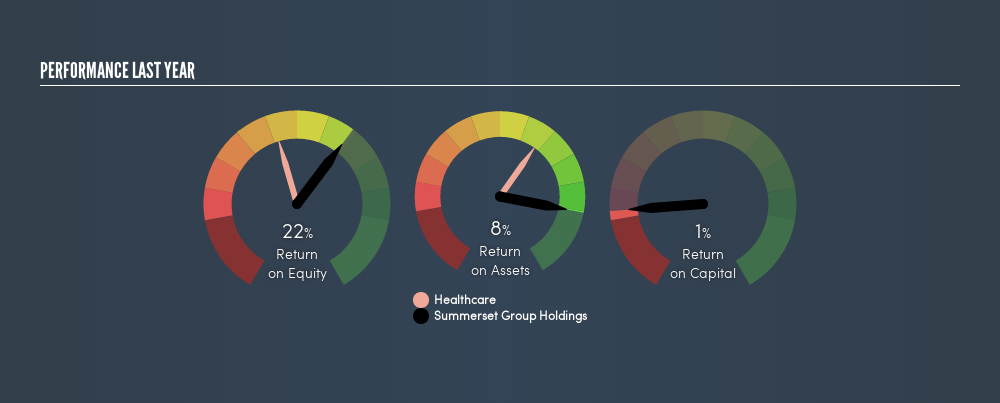- New Zealand
- /
- Healthcare Services
- /
- NZSE:SUM
Why Summerset Group Holdings Limited’s (NZSE:SUM) Use Of Investor Capital Doesn’t Look Great

Want to participate in a short research study? Help shape the future of investing tools and you could win a $250 gift card!
Today we'll evaluate Summerset Group Holdings Limited (NZSE:SUM) to determine whether it could have potential as an investment idea. To be precise, we'll consider its Return On Capital Employed (ROCE), as that will inform our view of the quality of the business.
First up, we'll look at what ROCE is and how we calculate it. Second, we'll look at its ROCE compared to similar companies. Finally, we'll look at how its current liabilities affect its ROCE.
What is Return On Capital Employed (ROCE)?
ROCE is a measure of a company's yearly pre-tax profit (its return), relative to the capital employed in the business. In general, businesses with a higher ROCE are usually better quality. Ultimately, it is a useful but imperfect metric. Author Edwin Whiting says to be careful when comparing the ROCE of different businesses, since 'No two businesses are exactly alike.'
How Do You Calculate Return On Capital Employed?
Analysts use this formula to calculate return on capital employed:
Return on Capital Employed = Earnings Before Interest and Tax (EBIT) ÷ (Total Assets - Current Liabilities)
Or for Summerset Group Holdings:
0.0068 = NZ$18m ÷ (NZ$2.8b - NZ$187m) (Based on the trailing twelve months to December 2018.)
Therefore, Summerset Group Holdings has an ROCE of 0.7%.
See our latest analysis for Summerset Group Holdings
Does Summerset Group Holdings Have A Good ROCE?
ROCE is commonly used for comparing the performance of similar businesses. Using our data, Summerset Group Holdings's ROCE appears to be significantly below the 0.9% average in the Healthcare industry. This performance is not ideal, as it suggests the company may not be deploying its capital as effectively as some competitors. Independently of how Summerset Group Holdings compares to its industry, its ROCE in absolute terms is low; especially compared to the ~2.4% available in government bonds. Readers may wish to look for more rewarding investments.

When considering ROCE, bear in mind that it reflects the past and does not necessarily predict the future. ROCE can be deceptive for cyclical businesses, as returns can look incredible in boom times, and terribly low in downturns. This is because ROCE only looks at one year, instead of considering returns across a whole cycle. What happens in the future is pretty important for investors, so we have prepared a freereport on analyst forecasts for Summerset Group Holdings.
How Summerset Group Holdings's Current Liabilities Impact Its ROCE
Liabilities, such as supplier bills and bank overdrafts, are referred to as current liabilities if they need to be paid within 12 months. The ROCE equation subtracts current liabilities from capital employed, so a company with a lot of current liabilities appears to have less capital employed, and a higher ROCE than otherwise. To counteract this, we check if a company has high current liabilities, relative to its total assets.
Summerset Group Holdings has total assets of NZ$2.8b and current liabilities of NZ$187m. As a result, its current liabilities are equal to approximately 6.8% of its total assets. With barely any current liabilities, there is minimal impact on Summerset Group Holdings's admittedly low ROCE.
The Bottom Line On Summerset Group Holdings's ROCE
Nonetheless, there may be better places to invest your capital. You might be able to find a better investment than Summerset Group Holdings. If you want a selection of possible winners, check out this freelist of interesting companies that trade on a P/E below 20 (but have proven they can grow earnings).
For those who like to find winning investments this freelist of growing companies with recent insider purchasing, could be just the ticket.
We aim to bring you long-term focused research analysis driven by fundamental data. Note that our analysis may not factor in the latest price-sensitive company announcements or qualitative material.
If you spot an error that warrants correction, please contact the editor at editorial-team@simplywallst.com. This article by Simply Wall St is general in nature. It does not constitute a recommendation to buy or sell any stock, and does not take account of your objectives, or your financial situation. Simply Wall St has no position in the stocks mentioned. Thank you for reading.
About NZSE:SUM
Summerset Group Holdings
Develops, owns, and operates integrated retirement villages in New Zealand and Australia.
Undervalued with acceptable track record.


